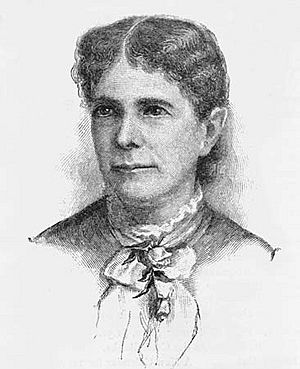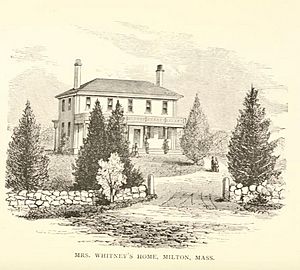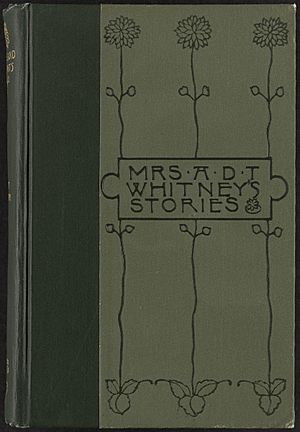Adeline Dutton Train Whitney facts for kids
Quick facts for kids
Adeline Train Whitney
|
|
|---|---|
 |
|
| Born | Adeline Train September 15, 1824 Boston, Massachusetts, U.S. |
| Died | March 20, 1906 (aged 81) Milton, Massachusetts, U.S. |
| Pen name | A. D. T. Whitney |
| Occupation | poet, writer |
| Language | English |
| Alma mater | School of George B. Emerson |
| Genre | Young girls |
| Spouse |
Seth Dunbar Whitney
(m. 1843) |
| Signature | |
Adeline Dutton Train Whitney (who also wrote as A. D. T. Whitney) was an American poet and writer. Born on September 15, 1824, she wrote over 20 books, mostly for young girls. Her stories were very popular during her lifetime. They often shared traditional ideas about women's roles in society.
Some of her popular books included Mother Goose for Grown Folks, Boys at Chequassett, Faith Gartney's Girlhood, The Gayworthys, and We Girls. She also wrote poetry collections like Pansies and Daffodils.
Contents
Early Life and Education
Adeline Dutton Train was born in Boston, Massachusetts, on September 15, 1824. Her father, Enoch Train, was a successful merchant. He owned ships and traded goods with other countries. Her cousin, George Francis Train, helped start the Union Pacific Railroad.
When Adeline was thirteen, her mother gave her all the stories by Maria Edgeworth. Reading these books helped shape her thoughts and made her dislike ordinary writing.
Adeline received most of her education in Boston. From age thirteen to eighteen (1837-1842), she attended the school of George B. Emerson. She also spent a year studying in Northampton.
Becoming a Writer
On November 7, 1843, Adeline married Seth Dunbar Whitney. He was a wealthy merchant from Milton. They lived in Milton and raised their family there. For many years, her duties at home kept her from writing much. She only wrote a few articles for religious magazines.
Whitney began writing seriously in her thirties, after her children started school. She first published poems and stories in local magazines. Her first book, Mother Goose for Grown Folks, came out in 1859.
In 1861, she wrote Boys at Chequasset. Then, in 1862, Faith Gartney's Girlhood was published. Both books were very successful right away. She continued to write many popular stories, including The Gayworthys (1864) and A Summer in Leslie Goldthwaite's Life (1866).
She also wrote We Girls (1870) and Hitherto (1869). Later, she published Real Folks (1871) and The Other Girls (1873). Her book Sights and Insights (1876) described the adventures of people traveling in Europe. In 1877, Whitney even put together a cookbook called Just How.
Her poems were collected in a book called Pansies in 1872. By 1879, all of her books were available in a special uniform edition.
Personal Life and Beliefs
Adeline Dutton Train Whitney believed that a woman's happiest place was in the home. She thought the home was the source of all good things. Because many parents agreed with these ideas, her books sold very well throughout her life.
She did not support women's suffrage (the right for women to vote). She also did not take part in public life. This was in line with the traditional views she wrote about in her books.
Her daughter, Caroline Leslie Field, also became a writer. She published prose and poems in magazines. Adeline Dutton Train Whitney passed away in Milton at the age of 81.
Themes in Her Stories
Whitney wrote mainly for young girls. She often showed how important family life and creating a good home were for women.
One of her most important stories is The Other Girls. In this book, she wrote about young women facing challenges in life. She showed great understanding and kindness for the feelings of young girls. For example, she described the excitement of a country girl named Bel Bree trying on a beautiful dress.
The story also showed how Bel Bree stood up for herself when a man offered her support without marriage. Whitney used this to show that family life and creating a home were the most important duties and glories for a woman. She also warned about the difficulties of choosing a public career, like becoming a platform reader, compared to the benefits of family life.
Selected Works
- 1857: "Footsteps on the Seas" (poem)
- 1859: Mother Goose for Grown Folks
- 1868: Boys at Chequasset
- 1863: Faith Gartney's Girlhood
- 1865: The Gayworthys
- 1866: A Summer in Leslie Goldthwaite's Life
- 1868: Patience Strong's Outings
- 1869: Hitherto
- 1870: We Girls
- 1871: Real Folks
- 1872: Pansies (poems)
- 1873: The Other Girls
- 1876: Sights and Insights
- 1878: Just How: A Key to the Cook Books
- 1880: Odd or Even
- 1885: Bonnyborough
- 1886: Homespun Yarns
- 1886: Holy Tides
- 1887: Daffodils
- 1888: Bird Talk
- 1890: Ascutney Street
- 1891: A Golden Gossip
- 1894: Square Pegs
- 1896: Friendly Letters to Girl Friends
- 1897: The Open Mystery: A Reading of the Mosaic Story
- 1900: The Integrity of Christian Science
See Also
- Caroline Leslie Field




